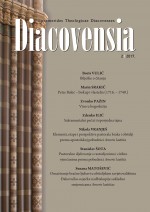Petar Bakić – biskup i vlastelin (1716. – 1749.)
PETAR BAKIĆ – A BISHOP AND A LANDOWNER (1716-1749)
Author(s): Marin SrakićSubject(s): Christian Theology and Religion
Published by: Katolički bogoslovni fakultet u Đakovu
Keywords: Bakić; missionary; Bosnian Diocese; Franciscans; Chamber supervision; manorial estate; economic amelioration; viticulture; legislator; sequester;
Summary/Abstract: 300 years ago, in 1716, Petar Bakić was appointed the Bishop of Bosnia or Đakovo, a priest of the (Arch)diocese of Split, a hardworking missionary of the Pannonian- Slavonian region, the »elected bishop of Srijem« (electus Sirmiensis). When Bakić took over his ministry, the traces of Turkish destruction were still visible in the diocese. That is why he wholeheartedly began to renovate the diocese beginning with the extension of the cathedral church, through the renovation of some parish churches, the acquiring of church furniture, etc. The diocese was small, only four parishes under pastoral care of the Franciscans of the Province of Bosnia Srebrena. His arrival marked the organized economic amelioration in all areas, such as viticulture, farming, livestock breeding, etc. Because of his fiery temper, the bishop often came into conflict with his surroundings: the Franciscans, the Chamber supervision in Osijek and the subjects. The Franciscans had defended their pastoral rights and invoked their merits, the military authorities had violated in all possible ways Bakić’s rights as a landowner, but also as a bishop, and the subjects complained to various levies and hard work in the landscaping of the estate. After countless lawsuits and accusations from both sides, the War Council under the presidency of Eugene Savoy, and with the consent of the imperial court, had sequestered bishop Petar Bakić, forbidding him to enter the area of his diocese. Much of what he in his diligence had planted and built was damaged or destroyed during his absence. When he returned to the diocese with the pardon of Empress Maria Theresa, he found a desolation that he could not bear and returned to his estate in Križovljan near Varaždin, where he died in 1749. He was buried in the local church, but the location of his grave is unknown.
Journal: Diacovensia: teološki prilozi
- Issue Year: 25/2017
- Issue No: 2
- Page Range: 189-230
- Page Count: 42
- Language: Croatian

